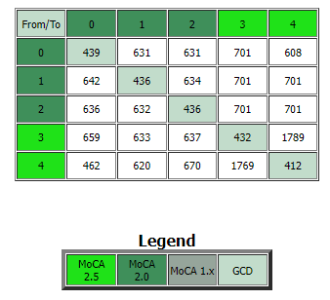Hi all,
A little background:
I've been working with Ethernet for ~30 years, but I'm a newbie with MoCA, so please forgive me if my questions (below) are naïve.
I'm on Xfinity cable, which enters (and splits) in the basement in a closet at one end of the house. The closet is shrouded by a metal beam, so there are WiFi access points connected to a wired business/workgroup router and cable modem in the closet.
The house is an open plan with no good location for a central WiFi router, so there are two SOHO WiFi routers configured as access points, one at each end of the house, which also serve wired clients.
I was using Powerline plugs to connect the "other end" AP to the router - but when one of the plugs died, I decided to try MoCA because there was existing coax available. So I got a pair of ScreenBeam ECB6250 (bonded 1Gbps) to experiment with.
My setup:


The results have been mixed: the MoCA bridge is more stable and faster than the Powerline, but testing with iPerf shows that a single TCP connection can achieve only 100..120 Mbps. I can get up to ~930 Mbps between wired clients across the MoCA bridge, but only in aggregate by using multiple TCP connections.
After the first few connections, the bandwidth of individual connections drops off slowly, but aggregate bandwidth keeps rising until the bridge is saturated with 15..18 simultaneous connections.
This is in contrast to Ethernet where a single TCP connection can use all the bandwidth.
Is this to be expected? I know MoCA creates multiple frequency channels, but I would have thought that the controller would spread Ethernet traffic across the channels to try to use all the bandwidth. Or is it just the case that the particular equipment I have doesn't do this?
Thanks,
George
A little background:
I've been working with Ethernet for ~30 years, but I'm a newbie with MoCA, so please forgive me if my questions (below) are naïve.
I'm on Xfinity cable, which enters (and splits) in the basement in a closet at one end of the house. The closet is shrouded by a metal beam, so there are WiFi access points connected to a wired business/workgroup router and cable modem in the closet.
The house is an open plan with no good location for a central WiFi router, so there are two SOHO WiFi routers configured as access points, one at each end of the house, which also serve wired clients.
I was using Powerline plugs to connect the "other end" AP to the router - but when one of the plugs died, I decided to try MoCA because there was existing coax available. So I got a pair of ScreenBeam ECB6250 (bonded 1Gbps) to experiment with.
My setup:
The results have been mixed: the MoCA bridge is more stable and faster than the Powerline, but testing with iPerf shows that a single TCP connection can achieve only 100..120 Mbps. I can get up to ~930 Mbps between wired clients across the MoCA bridge, but only in aggregate by using multiple TCP connections.
After the first few connections, the bandwidth of individual connections drops off slowly, but aggregate bandwidth keeps rising until the bridge is saturated with 15..18 simultaneous connections.
This is in contrast to Ethernet where a single TCP connection can use all the bandwidth.
Is this to be expected? I know MoCA creates multiple frequency channels, but I would have thought that the controller would spread Ethernet traffic across the channels to try to use all the bandwidth. Or is it just the case that the particular equipment I have doesn't do this?
Thanks,
George


